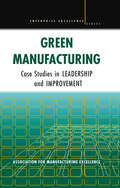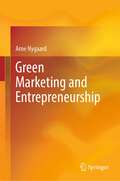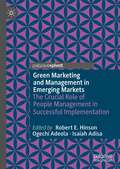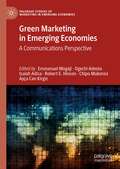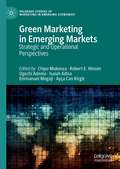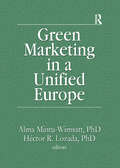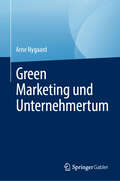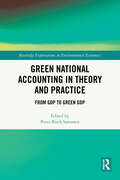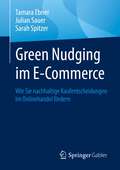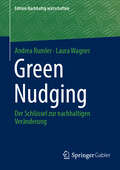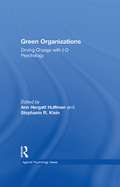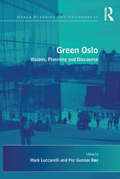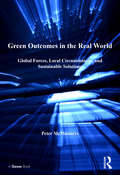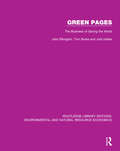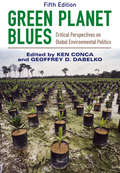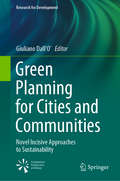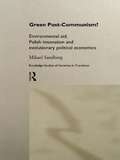- Table View
- List View
Green Manufacturing: Case Studies in Lean and Sustainability
by AME.No manufacturer can afford to ignore the pressing environmental issues of today. To do so puts both their profit line and their legacy at risk. As part of the Enterprise Excellence Series, this book brings together articles and case studies covering environmental, and energy issues that were previously published in the Association of Manufacturing Excellence‘s Target Magazine. It covers both areas of moral responsibility, as well as legal and economic considerations. Chapters are organized in three areas: Protecting the Environment, Using Energy Wisely, and EPA Case Studies, making it easy to track down the information desire.
Green Marketing 4.0: Ein Marketing-Guide für Green Davids und Greening Goliaths
by Andrea Grimm Astin MalschingerDieser Marketing-Guide führt Entscheider von nachhaltigen Unternehmen, grünen Marken sowie von Anbietern im Massenmarkt vom Status quo des heutigen grünen Marketings durch den Wandel von 4.0 und dessen treibende Kräfte. Die Autorinnen greifen dabei Philip Kotlers Ansatz von Marketing 4.0 auf und überführen diesen in die Welt des Nachhaltigkeitsmarketings. Sie zeigen auf, wie Green Marketer die Transformation der grünen Märkte im 4.0-Zeitalter aktiv mitgestalten. Wie können Green Davids ihre Position als Vertrauens- und Qualitätsführer behalten oder ausbauen? Welchen Beitrag leisten Greening Goliaths in der Transformation grüner Märkte? Wie relevant ist die Wir-Ökonomie in Zukunft? Wie lassen sich Spannungsfelder wie „Greenwashing“ oder „Green Glamour“ lösen? Das Buch beleuchtet diese und weitere Fragen, liefert Modelle und Hintergründe, gibt Impulse mit zahlreichen Beispielen und bietet ein umfassendes Set an Essentials für die Umsetzung.
Green Marketing and Entrepreneurship
by Arne NygaardThis comprehensive book reveals the intricate interplay between entrepreneurship, strategy, and marketing management in the context of sustainability. The book champions the green shift within businesses and organizations, equipping both companies and consumers with the knowledge needed to make well-informed decisions that drive positive market transformations. Providing a holistic understanding of sustainable and disruptive change processes for students and professionals, it looks into a spectrum of powerful strategies, ranging from green marketing approaches and segmentation techniques to the nuances of demarketing and green branding. Readers will uncover the critical role of companies and decision-makers in reshaping consumer behavior and supply chains, while navigating potential pitfalls like the "tragedy of the commons" and "greenwashing." Furthermore, they will gain valuable insights into how strategic positioning and targeted efforts can yield sustainable outcomes and increase consumer willingness to invest in environmentally conscious products. Green Marketing and Entrepreneurship allows readers to explore the profound impact of marketing strategies on the delicate balance of nature and discover actionable green marketing methodologies that can pave the way for a more sustainable and environmentally conscious world.
Green Marketing and Management in Emerging Markets: The Crucial Role of People Management in Successful Implementation (Palgrave Studies of Marketing in Emerging Economies)
by Ogechi Adeola Robert E. Hinson Isaiah AdisaAdverse environmental impacts such as greenhouse gas emissions and chemical spills have put the topic of green business firmly on the sustainability agenda. Despite the burgeoning literature on green business and green marketing from the globalised north, there is relative parsimony of green business literature in the global south. This book offers a greater understanding of what green marketing is, as well as the various levels of practices and the implementations thereof. It places specific emphasis on the people through which green marketing excellence can be achieved. Contributors argue that, given the complexity of green marketing, people management plays a key role in achieving green marketing success, and the chapters consider the role that green human resource management practices play in marketing.Providing a unique perspective on the successful implementation of green marketing, this book is an important resource for students, researchers and practitioners. It is of particular interest to those who desire a greater understanding of how organisations deal internally and externally with increasing pressure to become more socially responsible and embed ‘greenness’ in all their marketing activities.
Green Marketing in Emerging Economies: A Communications Perspective (Palgrave Studies of Marketing in Emerging Economies)
by Emmanuel Mogaji Ogechi Adeola Robert E. Hinson Chipo Mukonza Isaiah Adisa Ayça Can KirgizLiterature on green marketing continues to gain traction in the sustainability discourse, focusing on core subject areas such as green product development, green marketing strategy and green advertising. Achieving green marketing success encompasses influencing, orientating, and communicating green offerings of an organisation to the consumers. Emerging markets particularly provide unique opportunities for green product innovations to thrive due to their rapid industrialisation and economic growth; hence the value proposition of organisations must be rightly communicated to the consumers. The book is part of a multi-volume work that highlights the goals of green marketing, such as influencing consumers’ green adoption, behaviour, and attitude towards sustainability practices. This book provides insights to researchers, students and practitioners interested in marketing and sustainability initiatives in the context of emerging markets. It is also recommended for marketing managers and brand consultants who desire an in-depth understanding of how to communicate their organisation’s green offerings while positioning the organisation as a green brand to influence consumers’ green purchasing behaviours.
Green Marketing in Emerging Markets: Strategic and Operational Perspectives (Palgrave Studies of Marketing in Emerging Economies)
by Emmanuel Mogaji Ogechi Adeola Robert E. Hinson Chipo Mukonza Isaiah Adisa Ayça Can KirgizGreen marketing has risen in prominence over recent years as corporations face calls to lower their carbon footprint, engage in socially responsible practices, and promote sustainable ways of conducting business. In emerging economies, social, economic, and environmental problems resulting from rapid industrialisation requires urgent attention. Promoting environmentally responsible practices through green marketing has been identified as a key solution.This book provides theoretical and practical insights into how businesses in emerging economies can integrate green objectives into their marketing activities to achieve sustainable outcomes and attain green-focused goals. It discusses green marketing from strategic and operational perspectives, which considers target consumers, products, processes, promotion and sustainability of resources and presents the institutional logic of embedding greenness across organisational marketing activities. Issues concomitant to green marketing such as consumer buying behaviour of green products, green integrated marketing communication, green product management, green initiatives in logistics social responsibility, greenwashing and the need for transparency, and green marketing orientations and firm performance, are covered in the book. Ultimately, this collection contributes to and extends theoretical conversations on green marketing while also providing actionable recommendations for organisations and the larger society in emerging economies.Chipo Mukonza is a Lecturer at the Tshwane University of Technology in Polokwane, South Africa. Ogechi Adeola is an Associate Professor of Marketing at the Lagos Business School, Pan-Atlantic University, Nigeria. Isaiah Adisa is a management researcher and consultant based in Nigeria.Robert E. Hinson is a Professor and Head of the Department of Marketing and Entrepreneurship at the University of Ghana Business School.Emmanuel Mogaji is a Senior Lecturer in Advertising and Marketing Communications at the University of Greenwich, United Kingdom.
Green Marketing in a Unified Europe
by Alma T Mintu-Wimsatt Hector R LozadaThe physical environment--its preservation, protection, and conservation--has become an urgent agenda for international marketers. Many marketing professionals have acknowledged that, in order to succeed, it is crucial that they integrate environmental considerations into their marketing strategies. Green Marketing in a Unified Europe gives marketing professionals insight into the opportunities available to competitively position themselves in the green environment, providing some companies with a much-needed strategic boost.Addressing the issue of green marketing at empirical and conceptual levels, contributors to Green Marketing in a Unified Europe give readers examples of how green marketing can be effectively integrated into international marketing. Chapters reveal green marketing’s repercussions on the corporate world, on governments and governmental agencies, and on societies. Marketing professionals learn the specifics of: European green marketing strategies the practice of sustainable development in Europe eco-friendly companies and their practices consumer green environmentalism European public policy and the green environmentThese chapters represent a compilation of current research on green marketing and the European and/or international communities. This information provides marketing professionals and government policymakers with a good research base for developing effective green marketing policies, rules, and regulations in their own countries and companies. Readers learn of opportunities for businesses to competitively position themselves through an environment-friendly philosophy or through a stronger pro-environment stance.Marketing professionals, academics interested in public policy and green/environmental marketing, multinational companies, and practitioners hoping to jump on the “green” bandwagon will find Green Marketing in a Unified Europe an invaluable guide to learning how sustainable development affects policy-making in the European Union. They can then see how green marketing consequently impacts upon their own practices in Europe and in other regions with green marketing policies.
Green Marketing und Unternehmertum
by Arne NygaardDieses umfassende Buch offenbart das komplexe Zusammenspiel von Unternehmertum, Strategie und Marketingmanagement im Kontext der Nachhaltigkeit. Das Buch befürwortet den grünen Wandel innerhalb von Unternehmen und Organisationen und stattet sowohl Unternehmen als auch Verbraucher mit dem Wissen aus, das erforderlich ist, um fundierte Entscheidungen zu treffen, die positive Markttransformationen vorantreiben. Es bietet ein ganzheitliches Verständnis für nachhaltige und disruptive Veränderungsprozesse für Studierende und Fachleute und untersucht ein Spektrum kraftvoller Strategien, die von grünen Marketingansätzen und Segmentierungstechniken bis hin zu den Feinheiten des Demarketings und des grünen Brandings reichen. Die Leser werden die entscheidende Rolle von Unternehmen und Entscheidungsträgern bei der Umgestaltung des Verbraucherverhaltens und der Lieferketten erkennen, während sie potenzielle Fallstricke wie die "Tragödie der Allmende" und "Greenwashing" navigieren. Darüber hinaus gewinnen sie wertvolle Einblicke, wie strategische Positionierung und gezielte Anstrengungen nachhaltige Ergebnisse erzielen und die Bereitschaft der Verbraucher erhöhen können, in umweltbewusste Produkte zu investieren. Green Marketing und Unternehmertum ermöglicht es den Lesern, die tiefgreifenden Auswirkungen von Marketingstrategien auf das empfindliche Gleichgewicht der Natur zu erkunden und umsetzbare grüne Marketingmethoden zu entdecken, die den Weg zu einer nachhaltigeren und umweltbewussteren Welt ebnen können.
Green Marketing: A Case Study Of The Sub-industry In Turkey
by Ayca KirgizGreen Marketing examines the concept of 'Green Marketing' using examples from Turkey and the rest of the world. The book examines Sa-ba Inc. as a case study which is among the pioneering enterprises in Turket's automative sub-industy and its green marketing strategies.
Green Monday
by Dawn Lau Jose B. Alvarez Billy ChanThis case describes the entrepreneurial journey of David Yeung, from campaigning for plant-based diets to building Green Monday, a purpose-driven business and an ecosystem based in Hong Kong comprising a retail platform, an alternative meat brand ("OmniPork"), a non-profit foundation, and an impact investment arm. Green Monday had been reshaping the traditional concept of plant-based food into a modern and aspirational lifestyle by providing more food options to the growing number of flexitarian consumers in Hong Kong and beyond. But in fall 2021, challenges were emerging that could slow its rapid growth. Externally, the breakdown of the global supply chain caused by the Covid-19 pandemic was affecting the company's expansion into new markets, such as mainland China, the U.S., and Southeast Asia. Internally, the strategy of operating multiple business models was testing the startup's ability to find a balance between growing the business without diluting its strong mission and purpose. Given these constraints, Yeung had some important decisions to make regarding Green Monday's growth plans. Should he continue the multi-business strategy or should he be more focused?
Green Money: How to Reduce Waste, Build Wealth, and Create a Better Future for All
by Kara PerezDiscover the path to a wealthier, more sustainable future Green Money: How to Reduce Waste, Build Wealth, and Create a Better Future for All is a startlingly insightful and compelling book that redefines personal finance through the twin lenses of environmental sustainability and community, offering actionable steps to not only improve your financial health but also make a positive impact on the planet. Kara Perez, a visionary in sustainable personal finance, shares her unique approach to breaking free from outdated financial advice, demonstrating how you can achieve a fulfilling life that values community, sustainability, and financial well-being. Filled with real-world anecdotes, cutting-edge research, and hands-on money exercises, this book equips you with the tools needed to take immediate action towards a brighter, greener future. You'll explore topics like: How to navigate the challenges of thrifting, tackle eco-anxiety, invest ethically, and engage in environmental justice, all while securing your financial future How overconsumption and reliance on fossil fuels became the norm and how we can find practical alternatives that work better for us and the planet Why systems, and not individuals, are the real problem Ideal for young professionals, growing families, entrepreneurs, small business owners, and financial planners alike, Green Money is more than a book—it's a movement towards integrating financial success with environmental stewardship. Join Kara Perez in transforming how you think about money and take the first step towards building wealth and creating a better future for all.
Green Mountain Coffee Roasters, Inc.
by Christopher Marquis Zoe YangA company with a strong commitment toward corporate social responsibility since its founding days, Green Mountain faced an ethical decision point in 2007 as new information from the field uncovered a chronic dire problem facing coffee communities-seasonal starvation. Company leaders are driven to re-assess their social impact and address this widespread problem while aligning their efforts with their broader, rapidly expanding business of selling coffee.
Green Mountain Coffee Roasters: Confidential Information for Negotiation with Keurig
by James K. Sebenius Shikhar Ghosh Thomas R. EisenmannCase provides confidential information for students assuming the role of Green Mountain Coffee Roasters (GMCR) senior executives in a negotiation to license technology from Keurig, a startup that has developed an innovative "portion pack" coffee brewing solution. The negotiation will determine the royalty to be paid to Keurig by GMCR, who will bear capital expenditures, and determine whether GMCR secures exclusive distribution rights to Keurig's system.
Green Nanomaterials: An Agriculture and Circular Economy Alternative (Nanotechnology in the Life Sciences)
by Ram Prasad Karen Esquivel Escalante Ana Angélica Feregrino Pérez Alicia Rosales PérezSince their first appearance, nanoscience and nanotechnology have focused on diverse materials science applications and more recently on agriculture as an emerging research area. New nanomaterials synthesis methods have been explored to reduce toxicological and chemical impact on the environment, such as through biosynthesis methods – using diverse bio sources of extracts as reductive and stabilizing agents, generating a sustainable synthesis. Although nanotechnology seems to be an approach for advanced agriculture, it is essential to know all nanomaterial action mechanisms, as these materials can be beneficial to specific organisms and detrimental to others. This book provides a comprehensive and scientifically robust exploration of the synthesis, characterization, and application of green synthesized nanomaterials in agriculture, framed within the principles of the circular economy. This book bridges the gap between nanotechnology and sustainable agricultural practices, offering insights into how green nanomaterials can enhance agricultural productivity while minimizing environmental impact. This book will serve as a key reference for researchers, practitioners, policymakers, and students in the fields of nanotechnology, agriculture, and environmental science. By providing a detailed and scientifically grounded examination of green synthesized nanomaterials, the book promotes sustainable agricultural practices that align with the principles of the circular economy.
Green National Accounting in Theory and Practice: From GDP to Green GDP (Routledge Explorations in Environmental Economics)
by Peter Birch SørensenThis book explains the theoretical and empirical foundations for constructing a measure of a country’s Green GDP and how this measure relates to the conventional GDP.Opening with an overview of the academic literature on green national accounting, the first chapter sets up an analytical model of the interaction between a small open economy and the environment to derive a theoretically founded measure of the economy’s Green Net National Income (“Green GDP”). The book then illustrates how the theory can be applied in practice to produce a time series for the evolution of Denmark’s Green GDP and its various components (with an emphasis on the environment) over the last thirty years. As far as possible, the data used in the calculations were constructed in accordance with international statistical guidelines. Therefore, the careful explanation of the methodology which is outlined in the book can be applied to other countries using comparable data.This book will be of significant interest to scholars in the field of environmental economics and statisticians and practitioners working on green national accounting.
Green Nudging im E-Commerce: Wie Sie nachhaltige Kaufentscheidungen im Onlinehandel fördern
by Tamara Ebner Julian Sauer Sarah SpitzerDieses Buch bietet einen Einstieg in die Entwicklung und Herausforderungen des nachhaltigen Konsumverhaltens im E-Commerce und zeigt auf, wie mittels Nudging im Onlinehandel bewusster Konsum gefördert werden kann. In den letzten Jahren hat sich ein gesteigertes Interesse an Nachhaltigkeit entwickelt und eine Vielzahl an Konsument:innen äußert die Absicht, bei Kaufentscheidungen vornehmlich ökologischen und sozialen Aspekten mehr Gewicht einzuräumen. In der Praxis lässt sich hingegen häufig beobachten, dass diese Absichten nicht in tatsächliche Handlungen überführt werden. Insbesondere im E-Commerce verleitet das komplexe und vielfältige Angebot dazu, einfache statt bewusste Entscheidungen zu treffen. Digital Green Nudges setzen hier an und können als „Anstupser“ verstanden werden, bei Konsument:innen Verhaltensänderungen zugunsten eines bewussten, ökologischen Konsums zu erwirken. Die Autor:innen liefern einen Überblick der verschiedenen Ausprägungen von Nudging im Allgemeinen und zeigen anhand von Praxisbeispielen auf, wie diese speziell auf den nachhaltigen Onlinehandel übertragen werden können. Der vorgestellte Handlungsleitfaden sowie die Evaluierung des Nudging-Konzepts helfen Onlinehändler:innen, selbst Digital Green Nudges zu konzipieren und deren Einsatz zielorientiert zu gestalten.
Green Nudging: Der Schlüssel zur nachhaltigen Veränderung (Edition Nachhaltig wirtschaften)
by Andrea Rumler Laura WagnerDieses Buch zeigt, wie man nachhaltiges Verhalten durch kleine, gezielte Anstöße – sogenannte Nudges – effektiv fördert. Zunächst führen die Autorinnen in die Bedeutung und Dringlichkeit nachhaltiger Veränderungen ein. Danach beleuchten sie die psychologischen Prinzipien, die dem Nudging-Ansatz zugrunde liegen, und stellen verschiedene Formen des Green Nudgings vor. Erfolgreiche Praxisbeispiele veranschaulichen die Wirkung dieses Ansatzes. Abschließend werden die Möglichkeiten und Grenzen von Green Nudging diskutiert und ein Ausblick auf zukünftige Potenziale gegeben. Die Autorinnen liefern allen, die nachhaltiges Handeln in Gesellschaft und Wirtschaft vorantreiben möchten, praxisnahe Einblicke und Werkzeuge, mit denen sie Green Nudging in verschiedenen Kontexten erfolgreich einsetzen können.
Green Organizations: Driving Change with I-O Psychology (Applied Psychology Series)
by Ann Hergatt Huffman Stephanie R. KleinThis book is a landmark in showing how industrial-organizational psychology and related fields contribute to environmental sustainability in organizations. Industrial-organizational psychology embraces a scientist/practitioner model: evidence-based best practice to solve real-world issues. The contributors to this book are experts in science and practice, demonstrating the ways in which human-organization interactions can drive change to produce environmentally beneficial outcomes. Overall, the authors address cogent issues and provide specific examples of how industrial-organizational psychology can guide interventions that support and maintain environmentally sound practices in organizations. Green Organizations can be used as a general reference for researchers, in courses on sustainable business, corporate social responsibility, ethical management practices and social entrepreneurship. The book will provide an excellent overview for anyone interested in sustainability in organizations, and will serve as a valuable guide to industrial-organizational psychology and management professionals.
Green Oslo: Visions, Planning and Discourse (Urban Planning And Environment Ser.)
by Per Gunnar RøeAs urban regions face the demand to decrease fossil fuel dependency, many cities in the developing world are undertaking initiatives designed to create a greener city by aiming for a more sustainable form of urban development and, to do so, they need to evaluate existing modes of transportation and patterns of land use. Focusing on Oslo, an early leader in urban environmental policy making and a European 'green city' award winner, it argues that this evaluation must adopt and integrate two approaches: firstly, as a process of ecological modernization based on a combination of transit, densification, and mixed use development and secondly, as an opportunity to reconsider the character and substance of the built environment as a reflection of natural values, landscapes and natural resources of the wider region. Environmental debate and concern is widespread in Oslo, and this is reflected in its earlier planning decisions to leave intact large forest reserves, its successful ecological restoration of the Oslo fjord, the importance of outdoor culture among its residents, the relatively progressive political agenda of Norway, This book provides an opportunity for a critical assessment of the limitations and opportunities inherent in 'green Oslo' and suggests the need for much broader integrative approaches. It concludes by highlighting lessons which other cities might learn from Oslo.
Green Outcomes in the Real World: Global Forces, Local Circumstances, and Sustainable Solutions
by Peter McMannersOver the last three decades the world economy has grown strongly on the back of 'globalization' supported by the policies of free-trade, open markets and privatisation. Support has also grown for the concept of 'sustainability', meeting the needs of the present without compromising the ability of future generations to meet their own needs. But as the Earth's systems come under increasing strain, the inherent conflict between sustainability and globalization has been exposed. Green Outcomes in a Real World examines the shift in thinking required to reconcile these two important areas of policy. In this ground breaking book, Peter McManners has coined the term 'Proximization' to define a new policy framework. The principles of Proximization are: 'sustainability', 'subsidiarity', 'primacy of the state' and 'market economics' and the application of these familiar concepts towards a sustainable globalised world is novel and different. The author argues that adherence to the principles of proximization will return world society to a stable natural order, and will mean changes. Global commodity flows will reduce and barriers to migration will increase. National governments will demand more control over their finances leading to restrictions on capital flows. Indeed, Peter believes that an element of 'selfish determination' is needed. The new world order will be sustainable by design. Global organisations such as the UN, national governments and global corporations will have to understand and apply a different paradigm. The arguments in this book do not reflect the idealism or even naivety of some of the green movement. This book is about hard-edged reality presented by an author with huge experience and a deep understanding of the business perspective. It will appeal to a wide range of professionals involved in setting policy and future direction for businesses, governments, and non-governmental bodies, as well as to those with an academic interest in business, economics, social and environmental issues, and public policy.
Green Pages: The Business of Saving the World (Routledge Library Editions: Environmental and Natural Resource Economics)
by John Elkington Tom Burke Julia HailesOriginally published in 1988. Europeans want a better environment. Increasingly, too, they are demanding the products, services, legislation and policies that will provide it. Green Pages reveals what Europe’s environmentalists plan to do next and how environmental pressures will threaten major markets – and at the same time opens up new opportunities for business, investment and employment. Green Pages is a fantastic reference source for green enterprise, and will be of interest to students of environmental economics.
Green Planet Blues
by Geoffrey D. Dabelko Edited by Ken ConcaRevised and updated throughout, this unique anthology examines global environmental politics from a range of perspectives#151;contemporary and classic, activist and scholarly#151;and reflects voices of the powerless and powerful. Paradigms of sustainability, environmental security, and ecological justice illustrate the many ways environmental problems and their solutions are framed in contemporary international debates about climate, water, forests, toxics, energy, food, biodiversity, and other environmental challenges of the twenty-first century. Organized thematically, the selections offer a truly global scope. Seventeen new readings discuss climate justice, environmental peacebuilding, globalization, land grabs, corporate environmentalism, climate adaptation, gender, disaster risk, resilience, and the future of global environmental politics in the wake of the #147;Rio+20” global summit of 2012. This book stresses the underlying questions of power, interests, authority, and legitimacy that shape environmental debates, and it provides readers with a global range of perspectives on the critical challenges facing the planet and its people.
Green Planet Blues
by Geoffrey D. Dabelko Edited by Ken ConcaRevised and updated throughout, this unique anthology examines global environmental politics from a range of perspectives#151;contemporary and classic, activist and scholarly#151;and reflects voices of the powerless and powerful. Paradigms of sustainability, environmental security, and ecological justice illustrate the many ways environmental problems and their solutions are framed in contemporary international debates about climate, water, forests, toxics, energy, food, biodiversity, and other environmental challenges of the twenty-first century. Organized thematically, the selections offer a truly global scope. Seventeen new readings discuss climate justice, environmental peacebuilding, globalization, land grabs, corporate environmentalism, climate adaptation, gender, disaster risk, resilience, and the future of global environmental politics in the wake of the #147;Rio+20” global summit of 2012. This book stresses the underlying questions of power, interests, authority, and legitimacy that shape environmental debates, and it provides readers with a global range of perspectives on the critical challenges facing the planet and its people.
Green Planning for Cities and Communities: Novel Incisive Approaches to Sustainability (Research for Development)
by Giuliano Dall’O’This book addresses key issues across the field of sustainable urban planning, and provides a unique reference tool for planners, engineers, architects, public administrators, and other experts. The evolution of cities and communities is giving rise to pressing energy and environmental problems that demand concrete solutions. In this context, urban planning is inevitably a complex activity that requires a sound analytical interpretation of ongoing developments, multidisciplinary analysis of the available tools and technologies, appropriate political management, and the ability to monitor progress objectively in order to verify the effectiveness of the policies implemented. This book is exceptional in both the breadth of its coverage and its focus on the interactions between different elements. Individual sections focus on strategies and tools for green planning, energy efficiency and sustainability in city planning, sustainable mobility, rating systems, and the smart city approach to improving urban-scale sustainability. The authors draw on their extensive practical experience to provide operational content supplementing the theoretical and methodological elements covered in the text, and each section features informative case studies.
Green Post-Communism?: Environmental Aid, Polish Innovation and Evolutionary Political Economics (Routledge Studies Of Societies In Transition Ser. #Vol. 10)
by Mikael SandbergThis book asks whether foreign aid can help post-communist societies to steer their technological innovation systems in more environmentally sound directions. Mikael Sandberg examines the legacy of Soviet-type innovation systems, then looks at opportunities for greener innovations in post-communist Poland, considering:* institutional transformation
